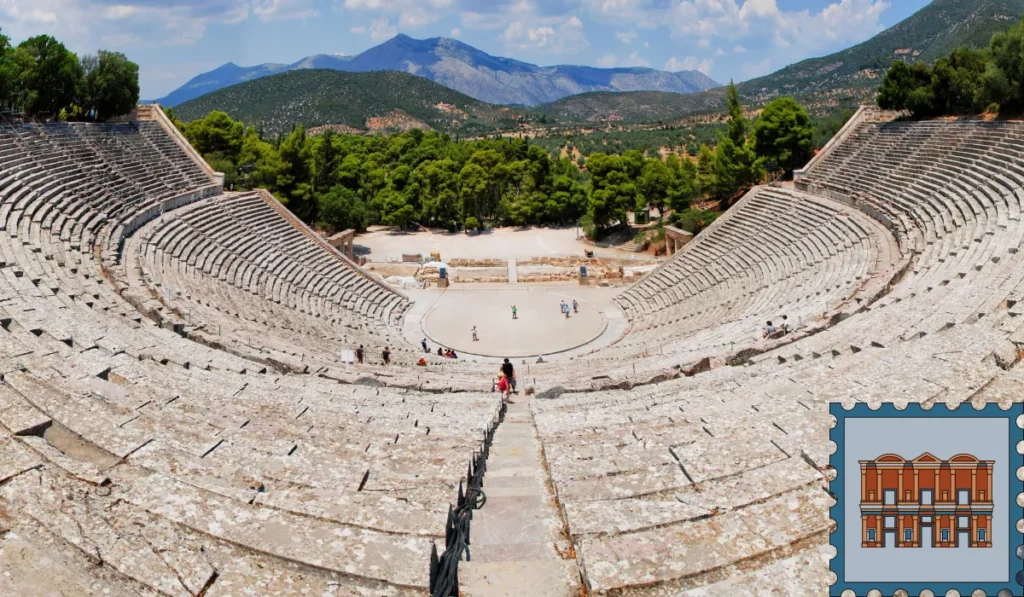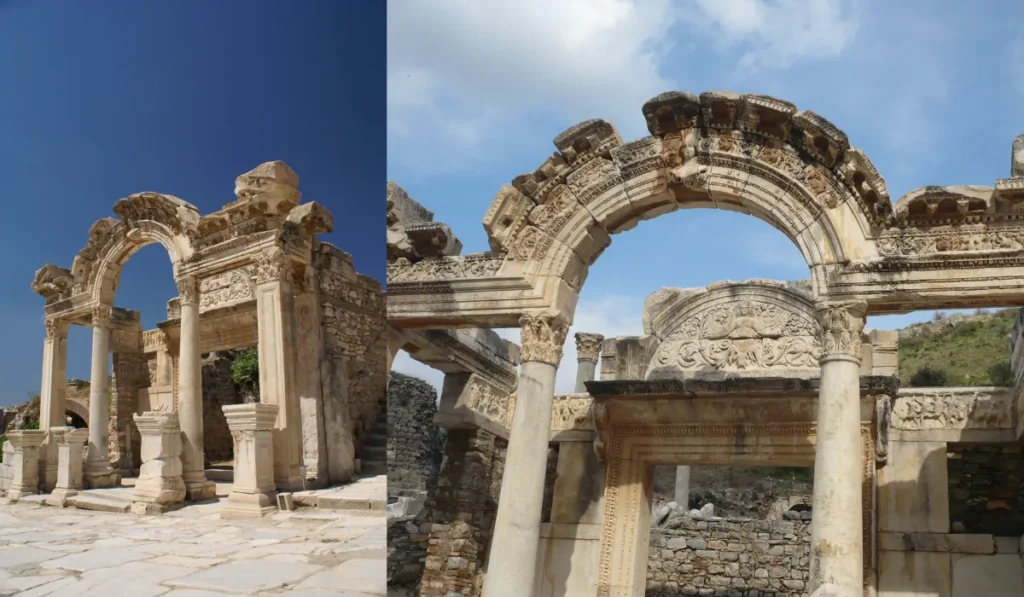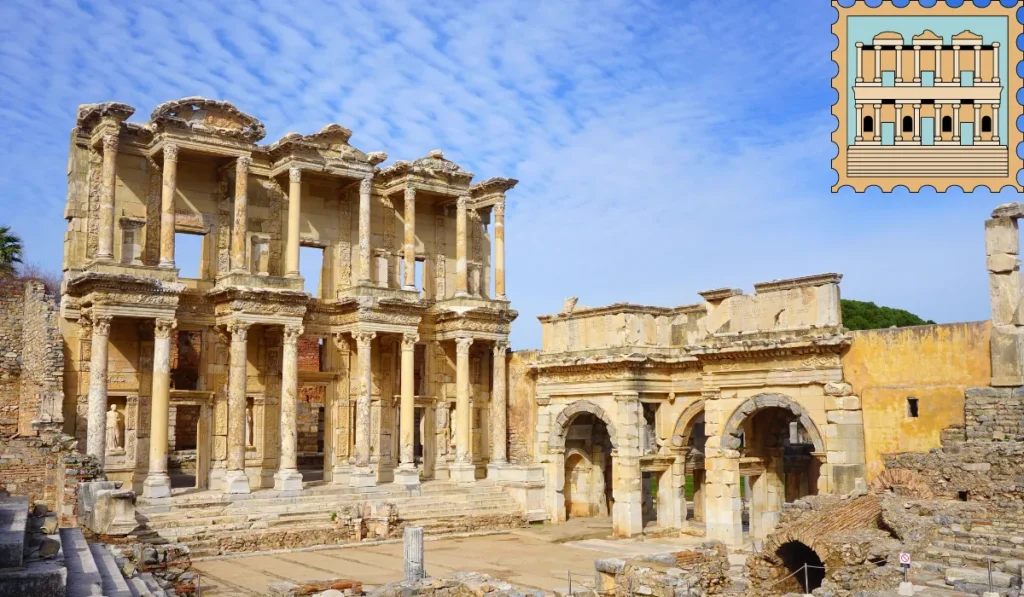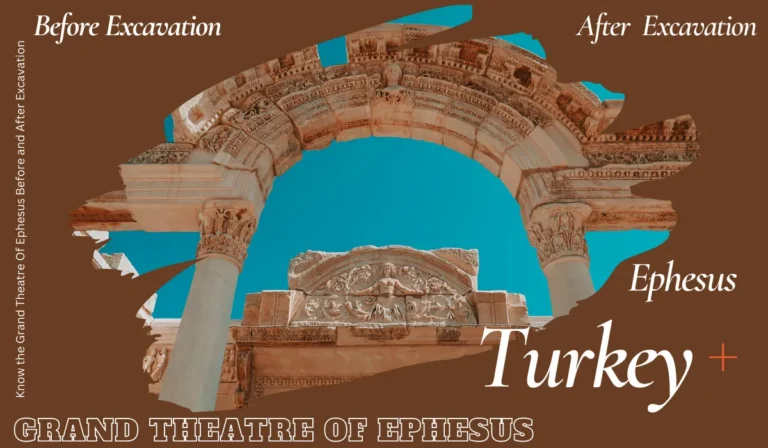Hey there! Are you prepared for a historical adventure? Curious about the captivating history of the Grand Theatre of Ephesus before excavation and after excavation? Let’s embark on this thrilling adventure to uncover the remarkable transformations it underwent! Trust me; this historical marvel will blow your mind!
The Grand Theatre of Ephesus Before Excavation: Discovering Hidden Gems
Alright, let’s rewind the clock back to the 1860s – a time when archaeologists struck gold! Picture this: dusty explorers stumbling upon the buried treasure that is the Grand Theatre of Ephesus. The old name of Ephesus was also “Ephesus.” It was an ancient Greek city located on the coast of present-day Turkey.
Whoosh! Cue the excitement among historians and archaeologists as they gear up to unravel the captivating tales hidden within its ancient walls!

Grand Theatre of Ephesus Before Excavation
First things first, let’s set the stage for Ephesus, a happening city in ancient Greece turned Roman metropolis, nestled in present-day Turkey. But wait, that’s not all! Prepare to be amazed as we uncover the architectural brilliance of the Grand Theatre. The first theater in ancient Greece was called the “theatron.” The ancient Greeks called a theater “theatron.” The word “theatron” translates to “seeing place” or “a place for viewing” in Greek.
Once upon a time, during the Hellenistic era, this jaw-dropping theater stood tall, boasting a whopping seating capacity of up to 25,000 spectators! Imagine the uproar of cheers and laughter as people gathered for epic performances. But that’s not all; the design was a fusion of Greek and Roman styles, a total mash-up of awesomeness! Columns and archways oozed elegance, while the façade was adorned with intricate carvings and sculptures – talk about a show-stopper!
What makes Ephesus so magnificent?
Picture Ephesus, a bustling city on the Aegean coast of Turkey, once a thriving hub of trade, culture, and spirituality. Its strategic location drew visitors from all corners of the ancient world.
- During the Hellenistic and Roman eras, the city prospered.
- Boasting splendid temples,
- lavish houses, and
- Awe-inspiring monuments that showcased its prosperity and opulence.
The Ephesus theatre is approximately over 2,000 years old. It dates back to the Hellenistic period and was further expanded during the Roman era.
Ephesus is believed to be named after the mythical figure “Ephesus,” the son of the river god Caystrus and the nymph Creusa in Greek mythology. According to legend, Ephesus was one of the founders of the ancient city, and it was named in his honor.

What made Ephesus culturally significant?
Ephesus held immense cultural importance with the famed Temple of Artemis, one of the Seven Wonders of the Ancient World, attracting worshippers from far and wide. The city was also home to a renowned school of philosophy, attracting scholars from across the Roman Empire. Ephesus, being a critical trading post connecting Asia and Europe, became a melting pot of diverse cultures.
And according to historical accounts in the Bible, the apostle Paul is said to have preached in the theater of Ephesus. The Book of Acts mentions that during his missionary journey, Paul spent time in Ephesus and addressed a large crowd of people in the theater, likely sharing his teachings and spreading the message of Christianity.
RELATED – 1 week or Months | How Long Is Dig Season In Egypt – Know Details
How did Ephesus get rediscovered?
Ephesus, like many ancient cities, was gradually abandoned and forgotten over time, buried beneath layers of earth. But in the 19th century, archaeologists and historians embarked on a mission to unearth its hidden wonders, breathing life back into its once-forgotten existence. This rediscovery sparked a renewed interest in ancient history, shedding light on the life and culture of the ancient world.
What challenges did the excavation process face?
Excavating Ephesus was no walk in the park! Archaeologists painstakingly unearthed the city’s remarkable structures, piece by piece, through a meticulous expedition and excavation process. Utilizing advanced techniques and tools, they carefully peeled back the layers of earth to reveal the hidden remnants of the ancient city, striking a delicate balance between preservation and discovery.
A Glimpse into the Past of Grand Theatre of Ephesus
How did the Grand Theatre come to be?
The Grand Theatre of Ephesus, a marvel of the ancient world, originated during the Hellenistic period and underwent expansion during the Roman era. Its meticulous design reflected the architectural brilliance of the time and was primarily used for various performances, like
- Theatrical Plays,
- Musical Presentations, and
- Gladiatorial Contests.
What makes the architectural features of the theater unique?
Get ready for this! The theater’s seating arrangements were carefully planned to accommodate up to 25,000 spectators, ranging from commoners to the wealthiest citizens of Ephesus. Its acoustics were exceptional, thanks to curved walls and strategically placed columns, ensuring clear audibility for every audience member, even in the distant seating areas.

Note : The oldest known Greek theater is the Theater of Dionysus Eleuthereus, located on the southern slope of the Acropolis in Athens, Greece.It is considered one of the earliest theaters in ancient Greece and is believed to have been built in the late 6th century BCE.
4. Grand Theatre of Ephesus in its Early Days
What kind of performances did the theater host?
Oh, the theater was the place to be during its heyday! Various theatrical productions, including tragedies, comedies, and satirical plays, captivated and entertained the audience. Musicians, dancers, and acrobats also showcased their talents, providing a diverse range of entertainment for the people of Ephesus.
What was the social and political importance of the amphitheater?
Beyond entertainment, the Grand Theatre played a crucial role in the ancient city’s social and political life. Citizens gathered there for cultural expression and civic discourse. Political speeches and public announcements were delivered from its stage, making it a hub of political activity and influence.
How did the theater promote ancient art and culture?
The Grand Theatre was more than just a performance venue; it was a platform for ancient art and culture. Renowned artists and performers showcased their craft there, attracting talent from far and wide. It reflected Ephesus’ commitment to fostering creativity and cultural expression.

Hope you are liking this “Grand Theatre of Ephesus Before excavation and after excavation” Article. If you have any questions after reading this article,please feel free to comment at the end.
Grand Theatre of Ephesus Buried for Centuries
What led to Ephesus’ decline and abandonment?
As the Roman Empire faced threats and began to decline, Ephesus lost its former glory. The invasion of the Goths in the 3rd century AD marked the beginning of its downfall, leading to eventual abandonment. Over time, the city was buried under layers of soil and debris, obscuring its grandeur.
What happened during Ephesus’ burial and how did it affect its memory?
For centuries, Ephesus remained buried and forgotten, existing only in the memories of those who once lived there. Its abandonment and burial marred the memory of its illustrious past, leaving behind only remnants and ruins. But hold on, there’s a silver lining!
Rediscovering the Hidden Gem of Grand Theatre of Ephesus
The Great Excavation Adventure: Challenges and Thrilling Discoveries
Alright, hold your breath! The excavation process wasn’t all smooth sailing; it was like a rollercoaster ride with twists and turns. Delicate artifacts demanded tender loving care, and pesky environmental factors tried to spoil the fun. But did our fearless archaeologists back down? Absolutely not!
As they delved deeper, a treasure trove emerged from the dust! Ancient artifacts and remnants of forgotten structures surfaced, whispering tales from centuries past. Each find was like finding a puzzle piece to complete the grand picture of the Grand Theatre of Ephesus!
How did the excavation efforts kick off?
The Grand Theatre of Ephesus was excavated in the 19th century. In the 19th century, the ambitious task of unearthing Ephesus and all its hidden treasures began. Archaeologists and historians set out on a mission to meticulously unearth the remains of Ephesus, breathing new life into the forgotten city.
What remarkable treasures were unveiled during excavation?
The excavation efforts uncovered a treasure trove of historical artifacts that shed light on the vibrant history and culture of Ephesus. Intricate marble sculptures, grand architectural fragments, and beautifully preserved artifacts emerged, each adding to the grandeur of Ephesus and providing valuable insights into its past.

The Grand Theatre of Ephesus After Excavation: Unveiling the Time Capsule:
Whoop-whoop! Our heroes did it! The Grand Theatre of Ephesus rose from the shadows, gleaming like a star in the archaeological sky. But wait, the adventure didn’t end there. Now came the part where our experts donned their superhero capes and got down to preserving this precious treasure.
The Impressive Restoration Efforts
How was the ancient splendor rebuilt?
The remarkable restoration efforts transformed the Grand Theatre into an awe-inspiring attraction, recreating its ancient splendor. Skilled craftsmen meticulously rebuilt and repaired the damaged portions of the theater, recreating its original form and beauty.
What advanced technologies aided the restoration?
While traditional methods played a significant role, advanced technologies were also enlisted to aid in the restoration process. 3D scanning and modeling techniques allowed for precise measurements and reconstructions, ensuring accuracy in replicating the original architectural elements. Cutting-edge conservation methods and materials were utilized, striking a balance between preservation and accessibility for future generations.
Before and After Excavation : The Grand Theatre of Ephesus
How did the Grand Theatre transform before and after excavation?
Before excavation, the Grand Theatre lay dormant beneath layers of earth, its true magnificence hidden from view. However, after the meticulous archaeological process, it emerged in all its glory! The once-buried theater revealed its splendid architectural features, showcasing the meticulous craftsmanship of the ancients.
What role did archaeological conservation play?
Archaeological conservation was the hero in this story! It played a crucial role in preserving and protecting the Grand Theatre after excavation. Conservationists utilized advanced techniques and materials to stabilize the fragile remnants of the theater, safeguarding it from environmental degradation.
What challenges and triumphs marked the restoration process?
The restoration process faced numerous challenges, but it triumphed in reviving the theater’s former glory. Archaeologists and conservationists overcame logistical hurdles and complex structural issues to recreate the theater’s original splendor. The meticulous restoration efforts breathed new life into the ancient ruins, allowing present-day visitors to experience the theater as it once was.

Present-Day of Grand Theatre of Ephesus After Excavation
What can visitors experience at the Grand Theatre today?
Today, the Grand Theatre stands as a testament to the ancient world’s architectural brilliance and attracts tourists from all over the globe. Visitors can marvel at the grandeur of the theater, exploring its well-preserved structure and immersing themselves in the rich history that it represents.
What cultural events take place at the theater now?
Beyond its historical significance, the Grand Theatre serves as a venue for various cultural events and live performances, continuing the tradition of entertainment from ancient times. Music concerts, theater productions, and dance performances grace the stage, providing a unique and immersive experience for visitors. The theater’s acoustics, just as impressive as they were in ancient times, contribute to the unparalleled auditory experience for both performers and audience members alike.
Calling All Explorers: The Grand Theatre of Ephesus Becomes a Tourist Hotspot
Get your cameras ready, folks! The Grand Theatre of Ephesus became an instant hit among travelers worldwide. It’s like a beacon calling out to all adventure seekers! Visitors flocked to witness the historical magnificence and get lost in the tales of ancient times.
Not Just a Blast from the Past: The Grand Theatre of Ephesus Today
Ta-da! The story doesn’t end there. The Grand Theatre of Ephesus is not just a relic of the past; it’s a vibrant hub of culture and art today! This ancient wonder serves as a venue for performances, events, and cultural festivals. Can you believe it? It’s like history coming to life!
Unraveling the Mysteries: The Significance of the Grand Theatre of Ephesus
Alright, here’s the grand finale! The Grand Theatre of Ephesus isn’t just any old theater; it’s a time machine connecting us with our ancestors. Unraveling its secrets has given us incredible insights into the lives and customs of ancient civilizations. Oh, and did I mention the architectural legacy? Yep, it’s influenced theaters worldwide! Talk about leaving a mark!

RELATED – 5 Main Archaeology Tools and Their Uses – archaeology tool kit – Must Know
Preservation and Protection of The Grand Theatre of Ephesus
How is the theater being preserved for the future?
Preserving the Grand Theatre for future generations requires continuous conservation efforts and vigilance. Ongoing monitoring and maintenance ensure that the delicate structures of the theater remain stable and protected from potential deterioration. Conservation teams work tirelessly to mitigate environmental factors and implement measures that safeguard the site from natural disasters and the impact of tourism.
Why is longevity crucial for future generations?
Efforts are being made to ensure the continued preservation and appreciation of the Grand Theatre for future generations. Education and awareness programs promote the significance of historical preservation and responsible tourism. By fostering an understanding of the importance of conservation, steps are taken to protect the theater’s integrity and ensure its longevity for years to come.
Conclusion:Time to Take a Bow:
Bravo, explorers! We’ve journeyed through time to uncover the wonders of the Grand Theatre of Ephesus before excavation and after excavation. From its buried past to its present-day glory, this ancient marvel has wowed us with its tales of history and architectural splendor.
The Grand Theatre of Ephesus stands as a magnificent architectural marvel that has defied time itself. From its ancient origins to its recent restoration, it continues to captivate visitors with its grandeur and historical significance.
So, the next time you’re in Turkey, don’t miss the chance to witness this living treasure. Happy exploring!
Hope you are got some information by reading this “Grand Theatre of Ephesus Before excavation and after excavation” Article. If you have any questions,please feel free to comment and please share.
FAQs (Frequently Asked Questions)
Can I explore the archaeological site of Ephesus today?
Absolutely! You can explore the archaeological site of Ephesus and witness the grandeur of the theater firsthand.
How old is the Grand Theatre of Ephesus?
The Grand Theatre dates back to the Hellenistic period and was later expanded during the Roman era, making it an ancient wonder.
Are there any restrictions for visitors inside the theater?
While visitors are free to explore the theater, climbing on the ancient structures is strictly prohibited to ensure preservation.
What is the significance of the theater’s acoustics?
Ah, the theater’s acoustics were extraordinary! Thanks to its clever design, everyone in the audience could hear the performances clearly, even those in the distant seats.
Can I attend live performances at the Grand Theatre today?
Yes, indeed! The theater is still a vibrant venue for various cultural events and performances, carrying on the tradition of entertainment from ancient times.
Is the Ephesus theatre used in modern times?
Yes, the Ephesus theater is still used in modern times. While it is no longer used for ancient performances and events, it serves as a major tourist attraction and a venue for cultural events and performances today.
